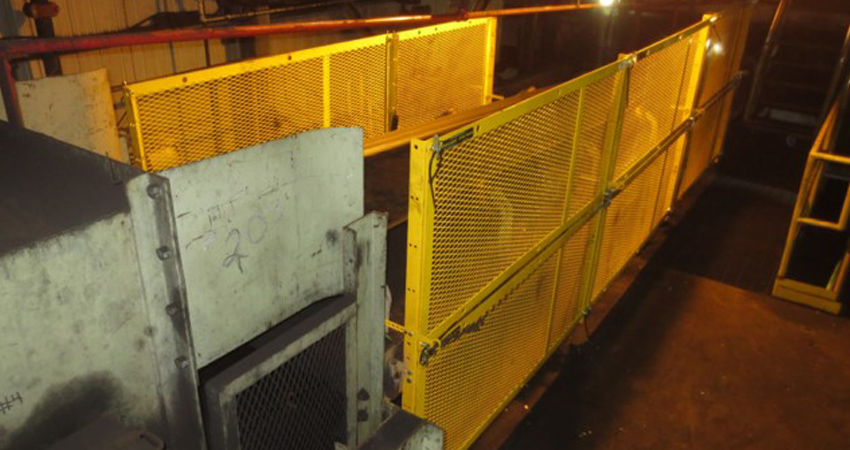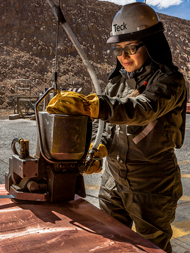Safety innovation at Coal Mountain Operations in support of our High-Potential Risk Control Strategy.
Strengthening our safety performance requires us to ask questions—such as, what are the risks that can cause serious and fatal injuries? What controls need to be put in place? And are our controls effective?
When the High-Potential Risk Control (HPRC) Strategy was introduced at Teck in 2014, Coal Mountain Operations (CMO) began Work Team Risk Assessments with a focus on the steam bay, but the team at CMO knew that broadening their critical review to all parts of the operation was the next important step toward creating a safer, healthier work environment.
“We engaged all our employees and asked them those big safety questions,” said Craig Bishop, Superintendent, Processing, CMO. “And from the feedback we gathered, the number one concern was working around moving conveyors.”
A team with representatives from various parts of the operation—plant operators, maintenance, labourers, training, health and safety—was assembled to go through the process of identifying the high-potential risks associated with the conveyors, and what measures were currently in place to control those risks.
CMO’s processing plant uses belt-type conveyors that move at high speeds; the review determined that the largest risks were associated with serious injury and fatalities resulting from the movement of the conveyors, employees’ proximity to them when working, and a lack of guarding around most areas of the equipment.
“From there, we realized we needed to increase our guarding campaign, but we also knew we couldn’t do it all at once and wanted to take a methodical approach,” says Craig. “Together with the project team, along with input from other areas of the plant, we prioritized the highest risk areas, based on the level of employee traffic around different parts of the conveyors, and got started from there.”
After evaluating options to determine what type of guarding would work best—including looking at fabricating it at CMO—the most effective and cost-efficient choice decided on was to purchase a lightweight guarding material that could be installed by pairs of operators and welders from CMO.
Installation work then began, and to date, more than 75% of the conveyors in the plant are now guarded, totalling more than 850 metres of protection in the highest priority areas.
“The feedback about the project has been incredibly positive,” said Craig. “It’s reinforced the understanding that it’s so important to speak up when it comes to safety, and that we’re listening to those concerns and taking action on them with real, practical solutions.”
A Closer Look: High-Potential Risk Control Strategy
At Teck, our High-Potential Risk Control (HPRC) Strategy captures the guiding principle that it is unacceptable to have serious injuries and fatalities in our workplace.
The HPRC Strategy is the result of a conscious decision to direct our safety efforts and resources towards events that have the greatest ability to seriously or fatally injure any member of our team. A key objective of the HPRC Strategy is to ensure we have effective controls in place for all high potential risks.
“Throughout the development of the HPRC Strategy, we continued to stress that although a number of critical controls may exist to manage a risk, it is individual employees who are the key to implementing them,” says Lawrence Watkins, Vice President, Health and Safety. “It is the women and men on the job every day who have to understand the risks associated with each task, so they can ensure the right controls are in place to stay safe.”
So what does it mean to “control” a risk? Put simply, it means putting measures in place to effectively manage a safety risk. “Critical controls” are the measures that, when implemented, are the most effective in preventing an unwanted event.
We can look back at incidents that have happened to identify many of our high-potential risks; however, this does not provide us with insight into other risks that may exist but that have not generated an incident. To help close this gap, both individual and team-based risk assessments have an important role to play.
During those team-based reviews–or Work Team Risk Assessments, like the one that sparked the implementation of the conveyor guarding at CMO–teams walk and talk through an everyday activity, asking the question: when I do this activity, what could potentially seriously or fatally injure me?
For those tasks that have a high-potential risk, they then ask what current and additional controls can be put in place and how we can review the effectiveness of these controls over time. Outcomes of the analysis are recorded and an action plan is then implemented and formally tracked to close the gaps.
It is our goal to ensure that every one of the more than 10,000 employees and contractors across Teck adopt the principles of our HPRC Strategy, as well as those of Courageous Safety Leadership. By doing so, we will achieve our vision of everyone going home safe and healthy every day.



